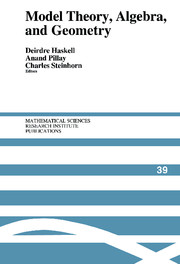Book contents
- Frontmatter
- Contents
- Overview
- Introduction to Model Theory
- Classical Model Theory of Fields
- Model Theory of Differential Fields
- A Survey on the Model Theory of Difference Fields
- Notes on o-Minimality and Variations
- Stability Theory and its Variants
- Subanalytic Geometry
- Arithmetic and Geometric Applications of Quantifier Elimination for Valued Fields
- Abelian Varieties and the Mordell-Lang Conjecture
Model Theory of Differential Fields
Published online by Cambridge University Press: 26 June 2025
- Frontmatter
- Contents
- Overview
- Introduction to Model Theory
- Classical Model Theory of Fields
- Model Theory of Differential Fields
- A Survey on the Model Theory of Difference Fields
- Notes on o-Minimality and Variations
- Stability Theory and its Variants
- Subanalytic Geometry
- Arithmetic and Geometric Applications of Quantifier Elimination for Valued Fields
- Abelian Varieties and the Mordell-Lang Conjecture
Summary
This article surveys the model theory of differentially closed fields, an interesting setting where one can use model-theoretic methods to obtain algebraic information. The article concludes with one example showing how this information can be used in diophantine applications.
A differential field is a field K equipped with a derivation δ : K → K; recall that this means that, for x,y ∈ K, we have δ (x + y) = δ (x) + 6(y) and δ (xy) = xδ (y) + yδ(x). Roughly speaking, such a field is called differentially closed when it contains enough solutions of ordinary differential equations. This setting allows one to use model-theoretic methods, and particularly dimensiontheoretic ideas, to obtain interesting algebraic information.
In this lecture I give a survey of the model theory of differentially closed fields, concluding with an example — Hrushovski's proof of the Mordell-Lang conjecture in characteristic zero — showing how model-theoretic methods in this area can be used in diophantine applications. I will not give the proofs of the main theorems. Most of the material in Sections 1-3 can be found in [Marker et al. 1996], while the material in Section 4 can be found in [Hrushovski and Sokolovic ≥ 2000; Pillay 1996]. The primary reference on differential algebra is [Kolchin 1973], though the very readable [Kaplansky 1957] contains most of the basics needed here, as does the more recent [Magid 1994]. The book [Buium 1994] also contains an introduction to differential algebra and its connections to diophantine geometry. We refer the reader to these sources for references to the original literature.
Information
- Type
- Chapter
- Information
- Model Theory, Algebra, and Geometry , pp. 53 - 64Publisher: Cambridge University PressPrint publication year: 2000
